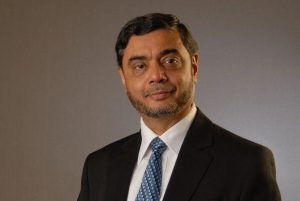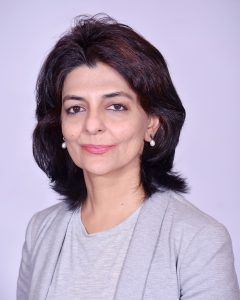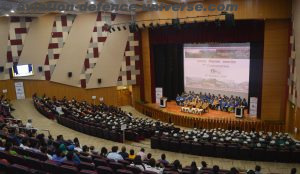New Delhi. 01 February 2022. A look at the Defence Budget 22-23 presented by Finance Minister Nirmala Sitharaman , as we go into print, is at the moment percentages and not figures . On the Defence front, the Government reiterates committed to reducing imports and promoting AtmaNirbharta in equipment for the Armed Forces. 68 per cent of the capital procurement budget will be earmarked for domestic industry in 2022-23, up from 58 per cent in 2021-22. Defence R&D will be opened up for industry, startups and academia with 25 per cent of defence R&D budget earmarked. Here are some reactions from the defence industry .
SP Shukla, President Society of Indian Defence Manufacturers (SIDM)

“SIDM welcomes announcement of setting aside 68% of capital outlay of defence budget for domestic industries. This will sustain investments and attract fresh capacity creation. Creation of a Nodal Body for setting up Testing and Certification requirements of defence systems and platforms will help domestic industry through faster processes and cost-efficiency. Allocation of 25% of Defence R&D budget for Startups, Academia and Private Industry is a much-needed reform. We thank Ministry of Defence and Ministry of Finance for this major boost to Research and Innovation,”
Cmde. Sujeet Samaddar, NM (Retd.) Hony Secy, Society for Aerospace Maritime and Defence Studies (SAMDES)

“Force levels need to reach the required numbers be it the Army, Navy or Airforce. Platforms in quantity need to fill the existing deficit. Modernisation and obsolesence will also need to be looked into for arms and equipment. There is no doubt that atmanirbharta must be the core of our force modernisation plan. But till we fulfil the existing deficits totally, imports will remain vital. So the budget hiking domestic sourcing to 68% maybe great news for industry but they will have to speedup up their act so that it is good news for armed forces too. We need it to match the quality and quantity of the adversary . Until then a very calibrated approach between balancing atmanirbharta and national security is required. The wholesome mantra will be Vasudeva Kutambikam along with atmanirbharta to achieve a GLOCAL model of industrial growth – fast, furious and fearsome.”
Ashmita Sethi, President & Country Head, Pratt & Whitney

“We congratulate the government on a strong, inclusive and growth focused budget in 2022. We believe that the far-sighted measures for energy transition, climate action, and advancing defense R&D with the private sector will be crucial towards securing India’s bright future. We would have liked to see additional aviation specific reforms this year, as the sector battles the significant impact of the pandemic.”
Ashish Saraf, VP and Country Director for Thales in India

“Thales welcomes the forward looking statements by the Union Finance Minister that seek to strengthen the vision of Aatmanirbhar Bharat. The allocation of 68 percent of the defence procurement budget for domestic equipment in FY23 is a positive step towards self-reliance. Moreover, efforts to foster innovation by earmarking 25% of Defence R&D budget to private firms, start-ups, and academia bode well for all stakeholders and will allow international OEMs to bring more technology into India. We also appreciate the budget’s emphasis on collaboration between government and industry, with private companies urged to take on the design and development of military platforms in collaboration with DRDO. These steps will enhance local capabilities and build our expertise at a world class level. We, at Thales, remain committed to strengthen our industrial footprint in India by developing our local teams, futuristic technologies and partnerships in line with the ‘Make in India’ initiative.”
Raman Sopory, Founder & President, Aerospace & Defence Consultants Association of India ( ADCAI )

“The capex allocation in Defence is reflection on the security threat perception . Accordingly for the FY 2022-23, the Govt of India has allocated INR 525,166.15 crore to the MoD. This is INR 46,970 crore or 10 percent more than the previous year’s allocation of INR 478,196 crore and the sharpest increase in the defence budget in recent years. hike in both the capital and revenue defence budget is significant at a time when India continues to remain locked in a military standoff with China in eastern Ladakh. The budget also announced the setting up of an independent nodal umbrella body for meeting wide-ranging testing and certification requirements, which is motivating.
Boost to Make in India , Indian Designed and Developed systems will attract foreign investment in Indian Private sector and create more jobs . Strengthening defence research and development holds the key. The government has encouraged the private sector, including start-ups, to engage in R&D. It has also instituted initiatives like the ‘Innovations for Defence Excellence’ to tap into the domestic innovation ecosystem.“
Vice Adm Paras Nath (Retd.) AVSM, VSM, Group President, Crown Group of companies (Defence Engineering Division)

“It is heartening to see that part of the R&D budget has been allocated to the industry, Start-ups and academia. This will be a positive move in particular to start ups and MSMEs to have their inhouse R&D. Some of our suggestions to help make India “AtmaNirbhar” in Defence manufacturing are:
1. A directive is necessary for PSUs to offer existing facilities with spare capacities to the Industry in line with the GOCO (Government Owned and Company Operated) policy
2. R&D support being provided to Industry and start-ups should have minimum 5 years gestation period
Ankit Agarwal, MD, STL(Sterlite Technologies)

“We believe that this budget will prove to be a Shot in the Arm for accelerating India’s Digital, Domestic and Defence ambitions. On the one side, it addresses digital connectivity for all through optical fibre and digital services in 100% of the villages by 2025. On the other side, it sets the foundation for India’s 5G readiness through spectrum auctions, R&D impetus, USOF allocation along with a boost for domestic manufacturing through a timely ‘Design-led manufacturing’ scheme. The move to allocate 68% of the Defence capital procurement budget for domestic players is also a positive stepping stone towards self-reliance in hi-tech manufacturing. At a macroeconomic level, a 35.4% increase in capital expenditure will bring necessary investments and drive consumption. As India braces to reap benefits from this progressive budget, greater policy impetus for procedural simplification, such as single window clearances and more conducive models for private public investments, would act as a multiplier.From a longer-term perspective, more Government investment in digital infrastructure would be absolutely essential for building a robust digital economy. In this context, a digital-first budget philosophy that focuses on digitalization of ministries’ budgetary allocations will ensure across the board acceleration of public services in addition to enhanced connectivity.”
Syed Qais Hayat (R), President Strategy & Operations, ARTPARK (AI & Robotics Technology Park)

“68% of defence procurement budget in 2022-23 is to be earmarked for domestic equipment. This is up from 58% in last fiscal. This will provide further impetus to greater participation of domestic industry in Defence Capital acquisitions. This is in line with the government’s approach to not import capital assets in all cases where the domestic industry can create products and solutions. Therefore, import of Capital assets for Defence will be resorted mainly in those cases which necessitate urgent procurements (generally self-defence) and in-house development of matching technology is unlikely in near to mid-term. This means the Ministry of Defence, its Departments and Services will have a larger than ever onus to carry out a thorough environment scan of in-house capabilities in defence production to identify, support and induct technologies, equipment and platforms to be able to justify any capital imports.”
































































































































